30 Years of Land Cover Change in Connecticut, USA: A Case Study of Long-Term Research, Dissemination of Results, and Their Use in Land Use Planning and Natural Resource Conservation
Abstract
:1. Introduction
2. Materials and Methods: Research
2.1. Overall Land Cover Change Analyses
2.2. Land Cover Change in Landscapes of Importance for Sustainability
2.3. Materials and Methods: Information Dissemination
3. Results: Research
3.1. Statewide Land Cover and Land Cover Change
3.2. Land Cover and Land Cover Change in Areas of Special Concern
4. Results: Information Dissemination
5. Discussion
6. Conclusions
Author Contributions
Funding
Acknowledgments
Conflicts of Interest
Appendix A
- Connecticut’s Changing Landscape Story Map: http://s.uconn.edu/ctstory
- Connecticut Conditions Online: https://cteco.uconn.edu/
References
- Messina, J.P.; Pan, W.K. Different ontologies: Land change science and health research. Curr. Opin. Environ. Sustain. 2013, 5, 515–521. [Google Scholar] [CrossRef] [PubMed] [Green Version]
- Patz, J.A.; Olson, S.H.; Uejio, C.K.; Gibbs, H.K. Disease emergence from global climate and land use change. Med. Clin. N. Am. 2008, 92, 1473–1491. [Google Scholar] [CrossRef] [PubMed]
- Feddema, J.J.; Oleson, K.W.; Bonan, G.B.; Mearns, L.O.; Buja, L.E.; Meehl, G.A.; Washington, W.M. The importance of land-cover change in simulating future climates. Science 2005, 310, 1674–1678. [Google Scholar] [CrossRef] [PubMed] [Green Version]
- Pielke, R.A., Sr. Land use and climate change. Science 2005, 310, 1625–1626. [Google Scholar] [CrossRef] [Green Version]
- Stephan, P.; Ennos, R.; Golding, Y. Modeling the environmental impacts of urban land use and land cover change—A study in Merseyside, UK. 2004. Landsc. Urban Plan. 2004, 71, 295–310. [Google Scholar] [CrossRef]
- Swenson, J.J.; Franklin, J. The effects of future urban development on habitat fragmentation in the Santa Monica Mountains. Landsc. Ecol. 2000, 15, 713–730. [Google Scholar] [CrossRef]
- Homer, C.; Dewitz, J.; Yang, L.; Suming, J.; Danielson, P.; Xian, G.; Coulston, J.; Herold, N.; Wickham, J.; Megown, K. Completion of the 2011 National Land Cover Database for the coterminous United States-representing a decade of land cover change information. Photogramm. Eng. Remote Sens. 2015, 81, 346–354. [Google Scholar]
- Yang, L.; Jin, S.; Danielson, P.; Homer, C.; Gass, L.; Bender, S.; Case, A.; Costello, D.; Dewitz, J.; Fry, J. A new generation of the United States National Land Cover Database: Requirements, research priorities, design, and implementation strategies. ISPRS J. Photogramm. Remote Sens. 2018, 146, 108–123. [Google Scholar] [CrossRef]
- Nolan, J.R. Protecting the Environment through Land Use Law: Standing Ground; Environmental Law Institute: Washington, DC, USA, 2014; pp. 1–22. [Google Scholar]
- Simis, M.J.; Madden, H.; Cacciatore, M.A.; Yeo, S.K. The lure of rationality: Why does the deficit model persist in science communication? Public Underst. Sci. 2016, 25, 400–414. [Google Scholar] [CrossRef] [Green Version]
- Whitmer, A.; Ogden, L.; Lawton, J.; Sturner, P.; Groffman, P.; Schneider, L.; Hart, D.; Halpern, B.; Schlesinger, W.; Raciti, S. The engaged university: Providing a platform for research that transforms society. Front. Ecol. Environ. 2010, 8, 314–321. [Google Scholar] [CrossRef] [Green Version]
- Civco, D.L.; Hurd, J.D. Multitemporal, Multisource Land Cover Mapping for the State of Connecticut. In Proceedings of the 1991 Fall Meeting of the American Society for Photogrammetry and Remote Sensing (ASPRS), Atlanta, GA, USA, 28 October–1 November 1991; pp. B141–B151. [Google Scholar]
- Civco, D.L.; Hurd, J.D. A Hierarchical Approach to Land Use and Land Cover Mapping using Multiple Image Types. In Proceedings of the 1999 American Society for Photogrammetry and Remote Sensing (ASPRS) Annual Convention, Portland, OR, USA, 17–21 May 1999; pp. 687–698. [Google Scholar]
- Anderson, T.H.; Taylor, G.T. Nutrient pulses, plankton blooms, and seasonal hypoxia in western Long Island Sound. Estuaries 2001, 24, 228–243. [Google Scholar] [CrossRef]
- Stocker, J.W.; Arnold, C.; Prisloe, S.; Civco, D. Putting Geospatial Information into the Hands of the “Real” Natural Resource Managers. In Proceedings of the 1999 American Society for Photogrammetry and Remote Sensing (ASPRS) Annual Convention, Portland, OR, USA, 17–21 May 1999; pp. 1070–1076. [Google Scholar]
- Arnold, C.L.; Civco, D.L.; Prisloe, S.; Hurd, J.D.; Stocker, J. Remote sensing-enhanced outreach education as a decision support system for local land use officials. Photogramm. Eng. Remote Sens. 2000, 66, 1251–1260. [Google Scholar]
- Wilson, E.H.; Rozum, J.; Arnold, C. Connecticut NEMO: Multi-faceted Geospatial Support for Local Land Use Decision Makers. In Proceedings of the 2004 ASPRS Conference, Images to Decision: Remote Sensing Foundations for GIS Applications, Kansas City, MO, USA, 12–16 September 2004. [Google Scholar]
- Hurd, J.D.; Wilson, E.H.; Civco, D.L.; Prisloe, S.; Arnold, C.L. Temporal Characterization of Connecticut’s Landscape: Methods, Results, and Applications. In Proceedings of the 2003 ASPRS Annual Convention, Anchorage, AK, USA, 2–9 May 2003. [Google Scholar]
- Koeln, G.; Bissonnette, J. Cross-correlation Analysis: Mapping Landcover Change with a Historic Landcover Database and a Recent, Single-date Multispectral Image. In Proceedings of the 2000 ASPRS Annual Convention, Washington, DC, USA, 21–26 May 2000. [Google Scholar]
- Smith, F.G.F.; Herold, N.; Jones, T.; Sheffield, C. Evaluation of Cross-correlation Analysis, a Semi-automated Change Detection, for Updating of an Existing Landcover Classification. In Proceedings of the 2002 ASPRS Annual Convention, Washington, DC, USA, 19–26 April 2002. [Google Scholar]
- Wilson, E.H.; Hurd, J.D.; Civco, D.L.; Prisloe, M.P.; Arnold, C.L. Development of a geospatial model to quantify, describe and map urban growth. Remote Sens. Environ. 2003, 86, 275–285. [Google Scholar] [CrossRef]
- USDA Natural Resources Conservation Service Soil Survey. Available online: https://www.nrcs.usda.gov/wps/portal/nrcs/main/soils/survey/ (accessed on 15 August 2019).
- Lowrance, R.; Altier, L.S.; Newbold, J.D.; Schnabel, R.R.; Groffman, P.M.; Denver, J.M.; Correll, D.L.; Gilliam, J.W.; Robinson, J.L.; Brinsfield, R.B. Water quality functions of riparian forest buffers in Chesapeake Bay watersheds. Environ. Manag. 1997, 21, 687–712. [Google Scholar] [CrossRef]
- Naiman, R.J.; Decamps, H. The ecology of interfaces: Riparian zones. Ann. Rev. Ecol. Syst. 1997, 28, 621–658. [Google Scholar] [CrossRef] [Green Version]
- Gold, A.J.; Groffman, P.M.; Addy, K.; Kellogg, D.Q.; Stolt, M.; Rosenblatt, A.E. Landscape attributes as controls on ground water nitrate removal capacity of riparian zones. J. Am. Water Resour. Assoc. 2001, 37, 1457–1464. [Google Scholar] [CrossRef]
- Mayer, P.M.; Reyonolds, S.K., Jr.; McCutchen, M.D.; Canfield, T.J. Meta-analysis of nitrogen removal in riparian buffers. J. Environ. Qual. 2007, 36, 1172–1180. [Google Scholar] [CrossRef]
- Library of the Connecticut Department of Energy and Environmental Protection. Available online: https://www.ct.gov/deep/lib/deep/water_inland/wetlands/2014statute.pdf (accessed on 15 August 2019).
- Bentrup, G. Conservation buffers: Design guidelines for buffers, corridors, and greenways. In General Technical Report SRS-109; Department of Agriculture, Forest Service, Southern Research Station: Asheville, NC, USA, 2008; p. 110. [Google Scholar]
- Sweeney, B.W.; Newbold, J.D. Streamside buffer width needed to protect stream water quality, habitat and organisms: A literature review. J. Am. Water Resour. Assoc. 2014, 50, 560–584. [Google Scholar] [CrossRef]
- Castelle, A.J.; Johnson, A.W.; Conolly, C. Wetland and stream buffer size requirements—A review. J. Environ. Qual. 1994, 23, 878–882. [Google Scholar] [CrossRef] [Green Version]
- Wilson, E.H.; Barrett, J.; Arnold, C.L. Land cover change in the riparian corridors of Connecticut. Watershed Sci. Bull. 2011, 2, 27–33. [Google Scholar]
- Riitters, K.H.; Wickham, J.D.; O’Neill, R.V.; Jones, K.B.; Smith, E.R. Global-scale patterns of forest fragmentation. Conserv. Ecol. 2000, 4, 1–28. [Google Scholar] [CrossRef]
- Riitters, K.H.; Wickham, J.D.; O’Neill, R.V.; Jones, K.B.; Smith, E.R.; Coulston, J.W.; Wade, T.G.; Smith, J.H. Fragmentation of continental United States forests. Ecosystems 2002, 5, 815–822. [Google Scholar] [CrossRef]
- Vogt, P.; Riitters, K.; Estreguil, C.; Kozak, J.; Wade, T.; Wickham, J. Mapping spatial patterns with morphological image processing. Landsc. Ecol. 2007, 22, 171–177. [Google Scholar] [CrossRef]
- Hurd, J.D.; Wilson, E.H.; Lammey, S.G.; Civco, D.L. Characterization of Forest Fragmentation and Urban Sprawl Using Time Sequential Landsat Imagery. In Proceedings of the ASPRS 2001 Annual Convention, St. Louis, MO, USA, 23–27 April 2001. [Google Scholar]
- Civco, D.L.; Hurd, J.D.; Wilson, E.H.; Arnold, C.L.; Prisloe, S. Quantifying and describing urbanizing landscapes in the northeast United States. Photogramm. Eng. Remote Sens. 2002, 68, 1083–1090. [Google Scholar]
- Hurd, J.D.; Wilson, E.H.; Civco, D.L. Development of a Forest Fragmentation Index to Quantify the Rate of Forest Change. In Proceedings of the 2002 ASPRS Annual Convention, Washington, DC, USA, 19–26 April 2002. [Google Scholar]
- Forman, R.T. Some general principles of landscape and regional ecology. Landsc. Ecol. 1995, 10, 133–142. [Google Scholar] [CrossRef]
- Forman, R.T.; Alexander, L. Roads and their major ecological effects. Annu. Rev. Ecol. Syst. 1998, 29, 207–231. [Google Scholar] [CrossRef] [Green Version]
- Arnold, C.L.; Gibbons, C.J. Impervious surface coverage: Emergence of a key environmental indicator. J. Am. Plan. Assoc. 1996, 62, 243–258. [Google Scholar] [CrossRef]
- Brabec, E.; Schulte, S.; Richards, P.L. Impervious surfaces and water quality: A review of current literature and its implications for watershed planning. J. Plan. Lit. 2002, 16, 499–514. [Google Scholar] [CrossRef]
- Schueler, T.; Fraley-McNeal, L.; Cappiella, K. Is impervious cover still important? Review of recent research. J. Hydrol. Eng. 2009, 14, 309–315. [Google Scholar] [CrossRef] [Green Version]
- Sleavin, W.; Prisloe, S.; Giannotti, L.; Stocker, J.; Civco, D. Measuring Impervious Surfaces for Non-point Source Pollution Modeling. In Proceedings of the ASPRS 2000 Annual Convention, Washington, DC, USA, 21–26 May 2000; p. 11. [Google Scholar]
- Prisloe, S.; Lei, Y.; Hurd, J. Interactive GIS-Based Impervious Surface Model. In Proceedings of the ASPRS 2001 Annual Convention, St. Louis, MO, USA, 23–27 April 2001. [Google Scholar]
- Rozum, J.; Wilson, E.H.; Arnold, C.L. Strengthening integration of land use research and outreach through innovative web technology. J. Ext. 2005, 43. Available online: http://www.joe.org/joe/2005october/iw1.shtml (accessed on 4 November 2019).
- Swift, M. Satellite Pinpoints State’s Sprawl. Hartford Courant, 4 January 2004; p. 1. [Google Scholar]
- Arnold, C. Sprawl: A Birds-Eye View. Hartford Courant, 21 March 2004; p. 14. [Google Scholar]
- Editorial Board. Maps Tell Sprawl Story. Hartford Courant, 22 March 2004; p. 12. [Google Scholar]
- Clear Changing Landscape Website. Available online: http://clear.uconn.edu/projects/landscape/index.htm (accessed on 15 August 2019).
- ESRI Story Map Website. Available online: https://storymaps.arcgis.com/ (accessed on 15 August 2019).
- Connecticut Office of Policy and Management. The Connecticut Economy, presentation to the Connecticut Tax Study Panel. 16 September 2015. Available online: https://www.cga.ct.gov/fin/tfs%5C20140929_State%20Tax%20Panel%5C20150916/FINAL%20CT%20Economy%20-%20OPM%20Presentation.pdf (accessed on 9 July 2020).
- Connecticut Department of Energy and Environmental Protection. Connecticut’s Inland Wetlands and Watercourses: Status and Trends Report for the Year 2010; Bureau of Water Protection and Land Reuse Inland Water Resources Division; Department of Energy and Environmental Protection: Hartford, CT, USA, 2012; Available online: https://www.ct.gov/deep/lib/deep/water_inland/wetlands/2010statusandtrendsreport.pdf (accessed on 15 August 2019).
- Connecticut Council on Environmental Quality. Environmental Quality in Connecticut 2018. Available online: https://www.ct.gov/ceq/cwp/view.asp?a=4992&Q=605334 (accessed on 15 August 2019).
- Connecticut Department of Energy and Environmental Protection. Comprehensive Open Space Acquisition Strategy 2016–2020 Green Plan. Available online: https://www.ct.gov/deep/lib/deep/open_space/greenplan/2016GreenPlan-CompletePlan.pdf (accessed on 15 August 2019).
- Connecticut Office of Policy and Management. Conservation and Development Policies: The Plan for Connecticut 2018–2023. Available online: https://portal.ct.gov/-/media/OPM/IGP/ORG/cdplan/20190214--Formatted-Document--20182023-Revised-State-CD-Plan.pdf?la=en (accessed on 15 August 2019).
- Connecticut General Legislature Website. Available online: https://www.cga.ct.gov/2017/act/pa/pdf/2017PA-00218-R00SB-00943-PA.pdf (accessed on 15 August 2019).
- Connecticut Department of Energy and Environmental Protection. Bacteria TMDL Website. Available online: https://www.ct.gov/deep/cwp/view.asp?a=2719&q=505808&depNav_GID=1654 (accessed on 15 August 2019).
- Bellucci, C.J. Stormwater and Aquatic Life: Making the Connection between Impervious Cover and Aquatic Life Impairments. In Proceedings of the Water Environment Federation Conference, Bellevue, WA, USA, 1–3 June 2007; pp. 1003–1018. [Google Scholar]
- Arnold, C.L.; Bellucci, C.J.; Collins, K.; Claytor, R. Responding to the first impervious cover-based TMDL in the nation. Watershed Sci. Bull. 2010, 1, 11–18. [Google Scholar]
- Dietz, M.E.; Arnold, C.; Milardo, K.; Miller, R. The care and feeding of a long term institutional commitment to green stormwater infrastructure: A case study at the University of Connecticut. J. Green Build. 2015, 10, 1–13. [Google Scholar] [CrossRef] [Green Version]
- U.S. Environmental Protection Agency TMDL Website. Available online: https://www.epa.gov/tmdl/innovative-tmdls-using-impervious-cover (accessed on 15 August 2019).
- Long Island Sound Study Website. Clean Waters and Health Watersheds Ecosystem Targets Page. Available online: http://longislandsoundstudy.net/our-vision-and-plan/clean-waters-and-healthy-watersheds/ (accessed on 15 August 2019).
- Wilson, B.; Charkraborty, A. The environmental impacts of sprawl: Emergent themes from the past decade of planning research. Sustainability 2013, 5, 3302–3327. [Google Scholar] [CrossRef] [Green Version]
- Statista Website. US Census Bureau Resident Population in Connecticut from 1960 to 2018 (Chart). Available online: https://www.statista.com/statistics/206104/resident-population-in-connecticut/ (accessed on 17 July 2019).
- Evans, M.J.; Rittenhouse, T.A.G.; Hawley, J.E.; Rego, P.W. Black bear recolonization patterns on human-dominated landscapes vary based on housing: New insights from spatially explicit density models. Landsc. Urban Plan. 2017, 162, 13–24. [Google Scholar] [CrossRef] [Green Version]
- U.S. EPA Website. Stormwater Discharges from Municipal Sources. Available online: https://www.epa.gov/npdes/stormwater-discharges-municipal-sources (accessed on 12 August 2019).
- Dickson, D.W.; Arnold, C.L.; Dietz, M.; LeFevre, M.; Kinnear, K.; Boyer, M. The status of Low Impact Development (LID) adoption in Connecticut. Watershed Sci. Bull. 2018, 10, 1–9. [Google Scholar]
- Mcdowell, G.R. Engaged universities: Lessons from the Land-Grant universities and Extension. Ann. Am. Acad. Polit. Soc. Sci. 2003, 585, 31–50. [Google Scholar] [CrossRef]
- Kellogg Commission on the Future of State and Land-Grant Universities. Returning to Our Roots: The Engaged Institution; The National Association of State Universities and Land Grant Colleges: Washington, DC, USA, 1999; p. 59. Available online: http://www.aplu.org/library/returning-to-our-roots-the-engaged-institution/file (accessed on 23 February 2020).
- Boyer, M.A.; Meinzer, M.; Bilich, A. The climate adaptation imperative: Local choices targeting global problems? Local Environ. 2017, 22, 67–85. [Google Scholar] [CrossRef]
- Boyer, M.A. Global Climate Change and Local Action: Understanding the Connecticut Policy Trajectory. Int. Stud. Perspect. 2013, 14, 79–107. [Google Scholar] [CrossRef]
- Barrett, J.; Hyde, B. Municipal Issues and Needs for Addressing Climate Adaptation in Connecticut. Report of the UConn Center for Land Use Education and Research and the Connecticut Sea Grant College Program. 2017, p. 23. Available online: http://clear.uconn.edu/publications/climate/Report_Municipal_Needs_Assessment_Sept_2017.pdf (accessed on 4 November 2019).

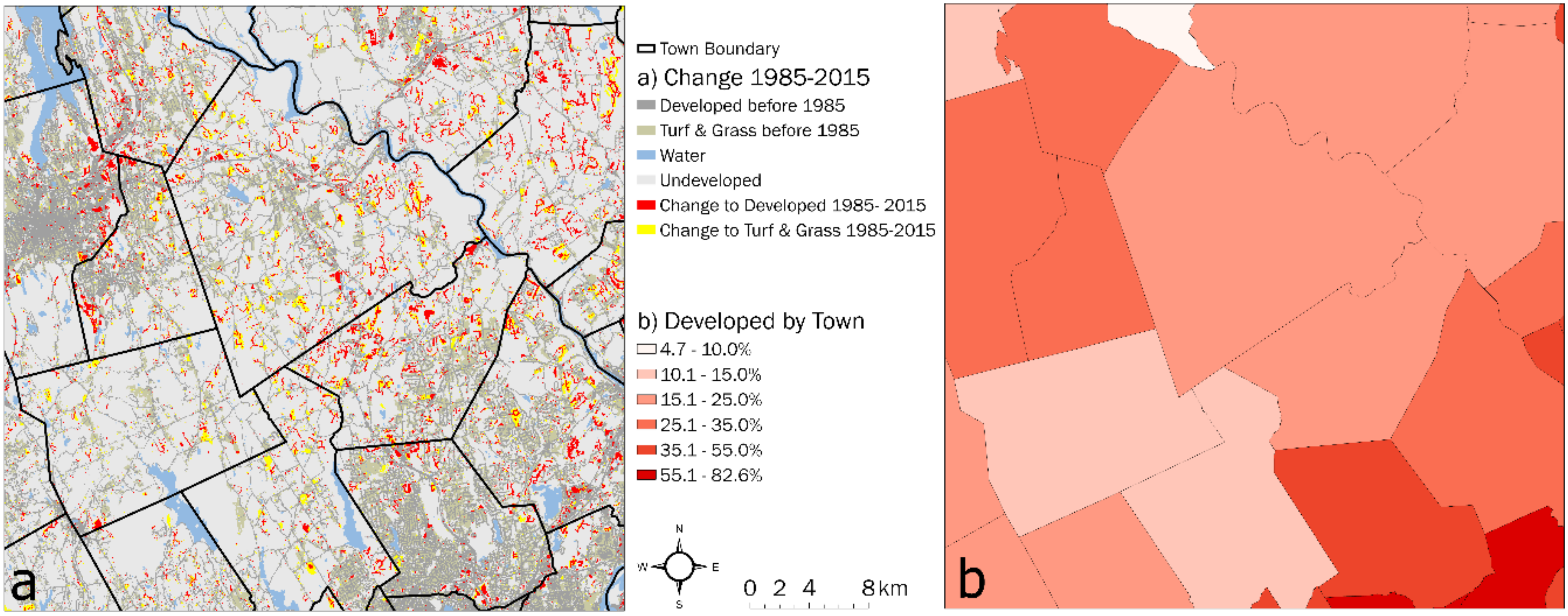
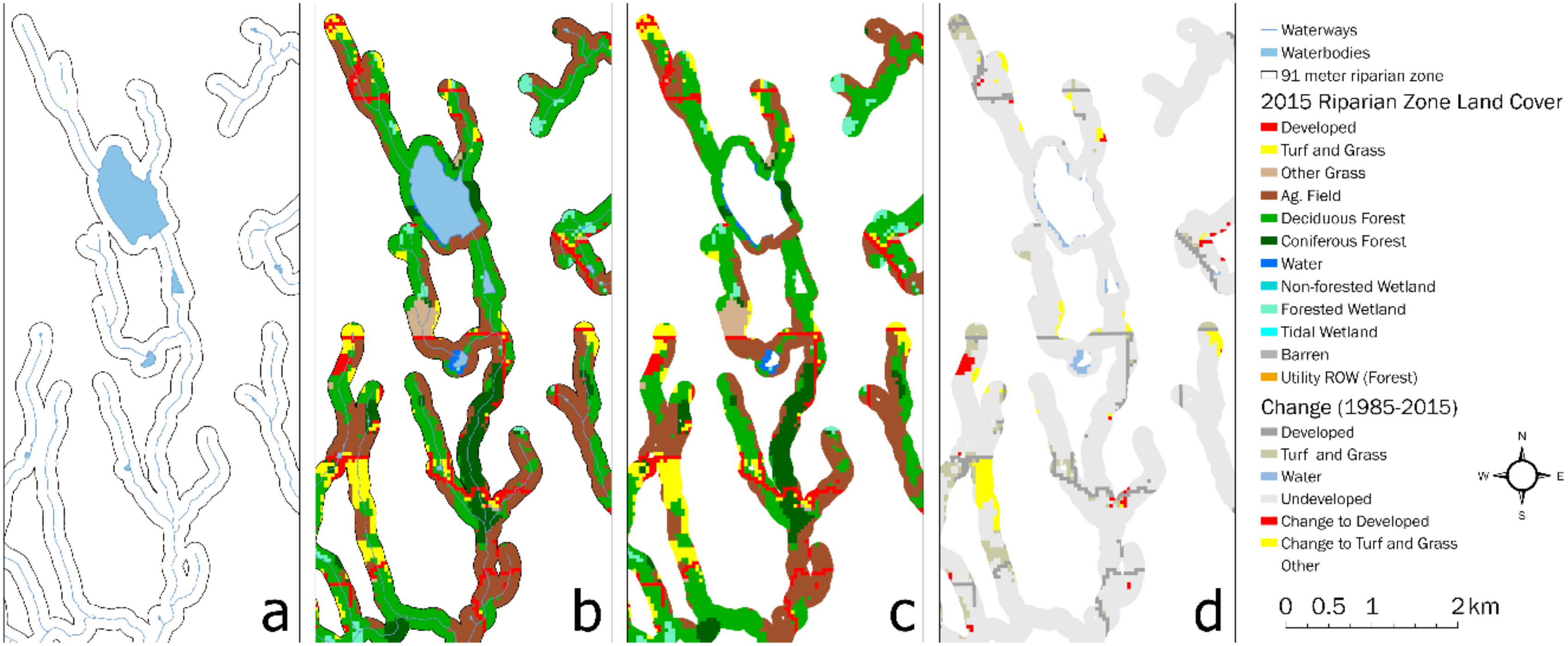
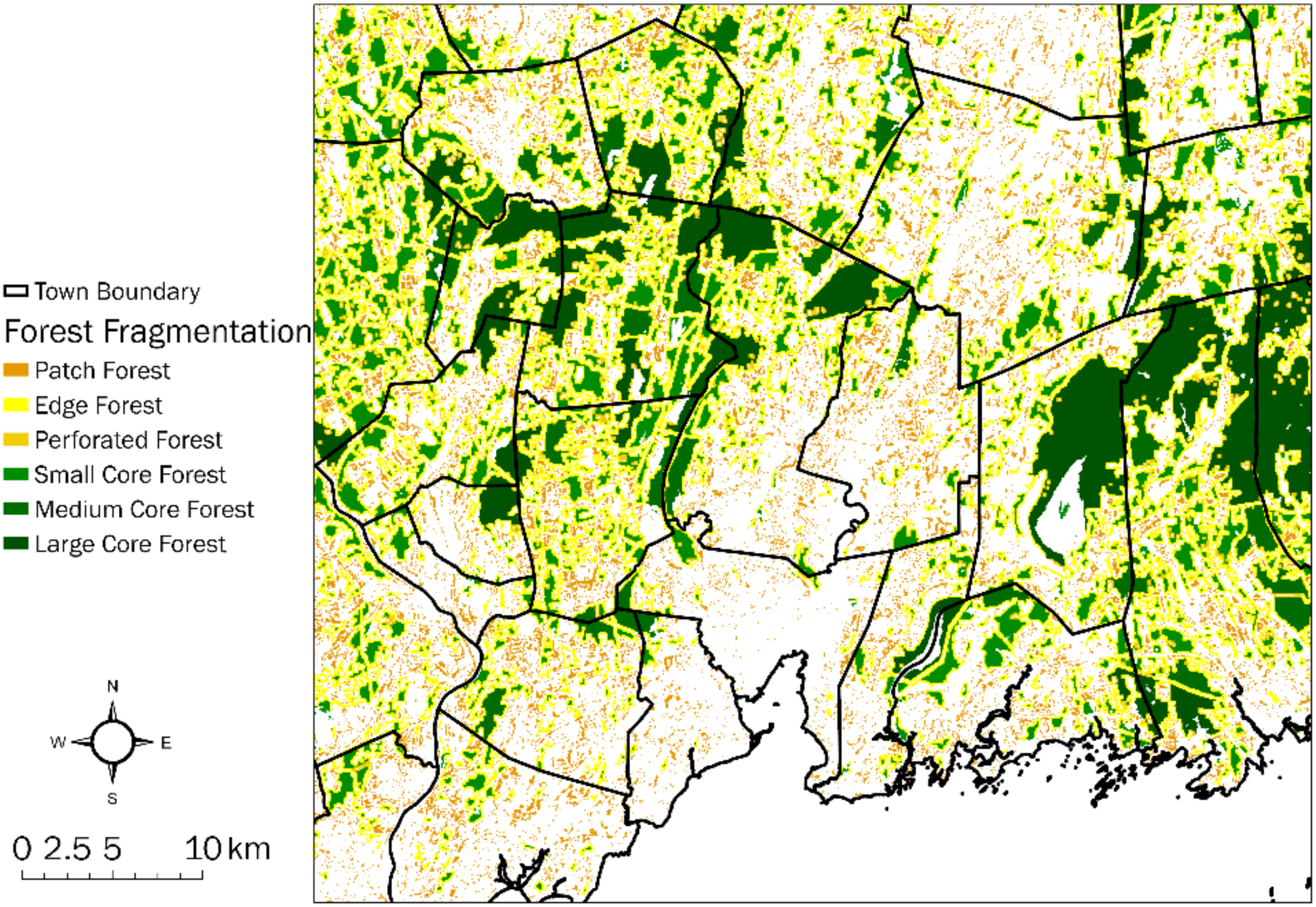
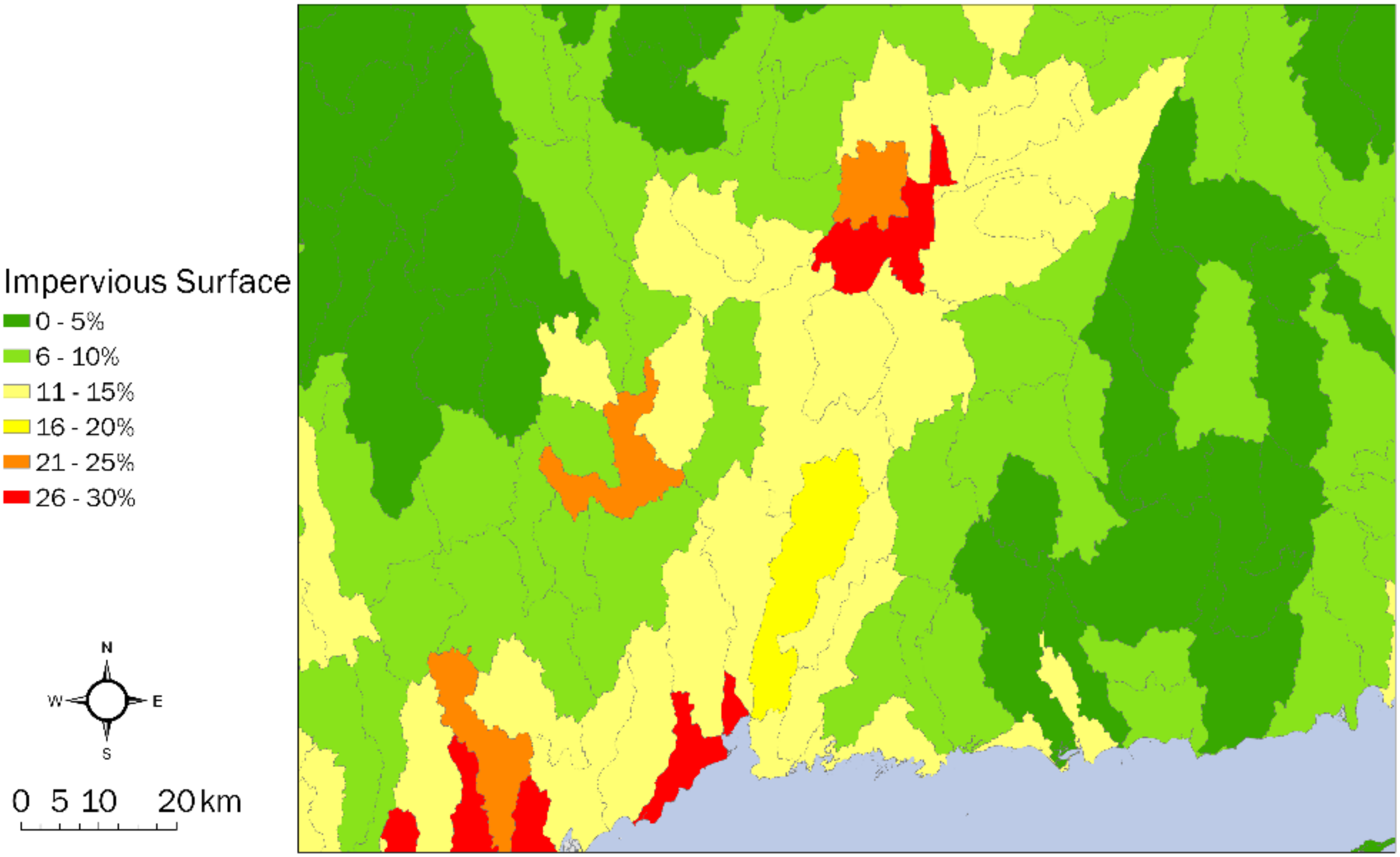

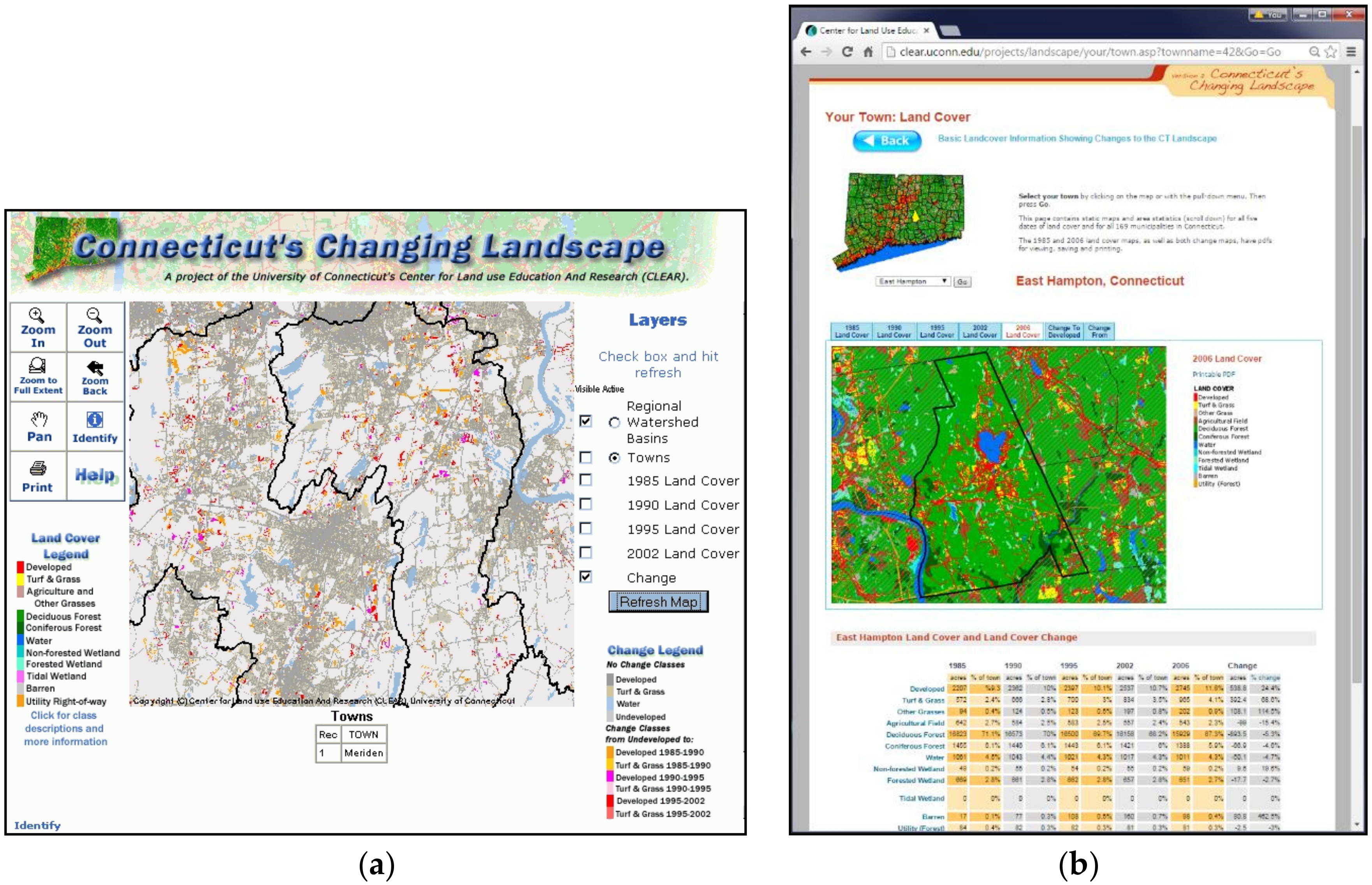
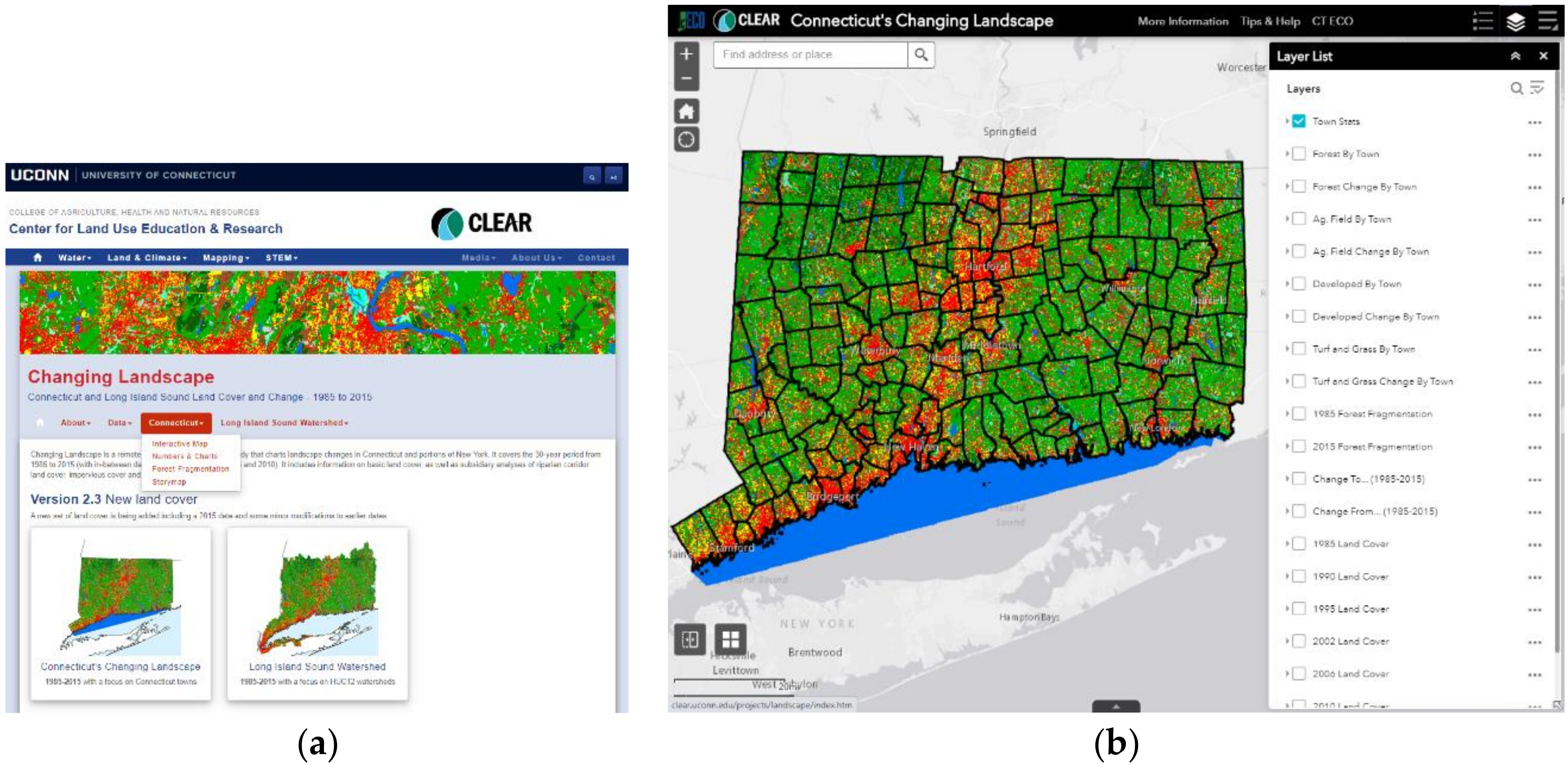

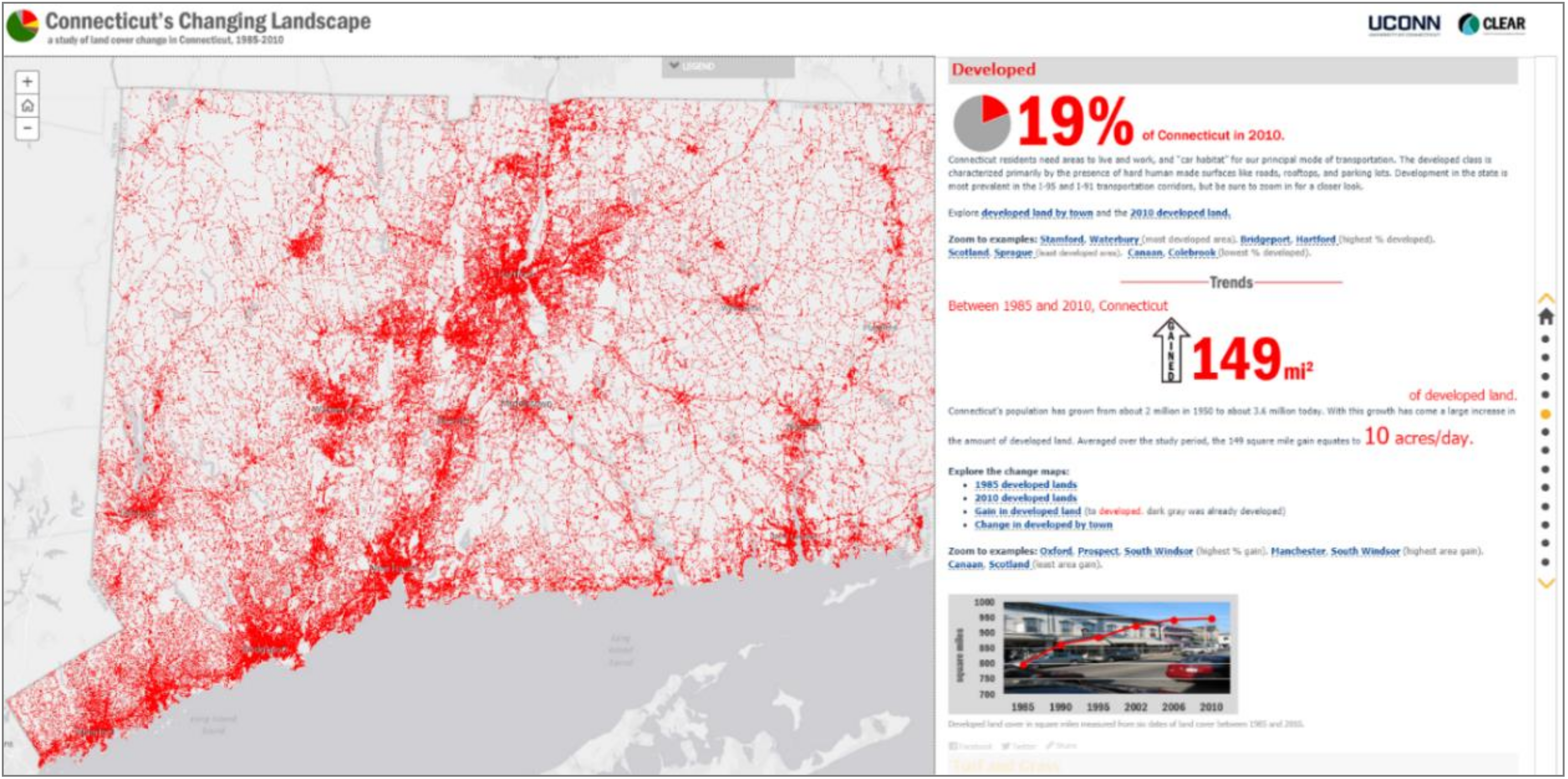
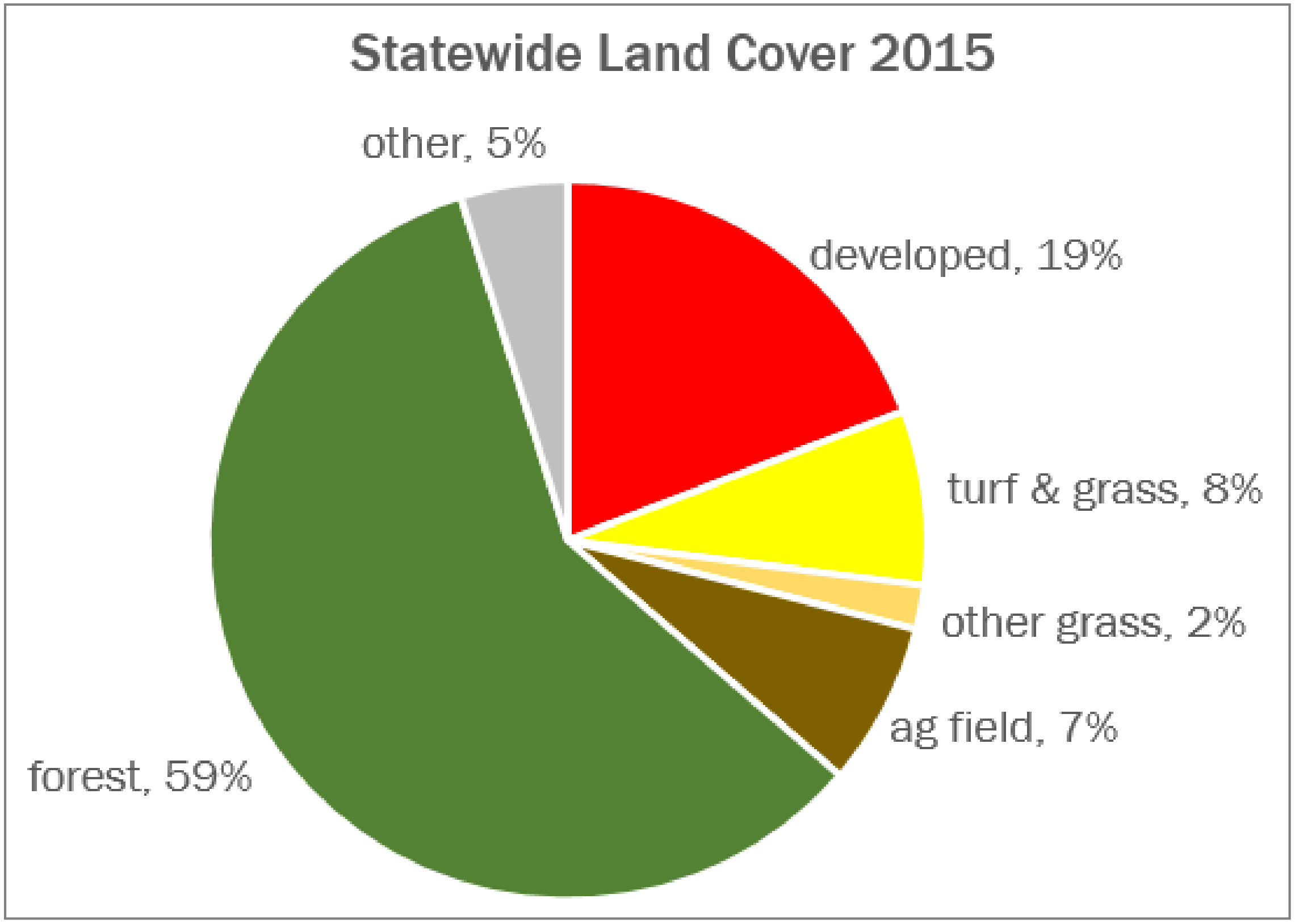
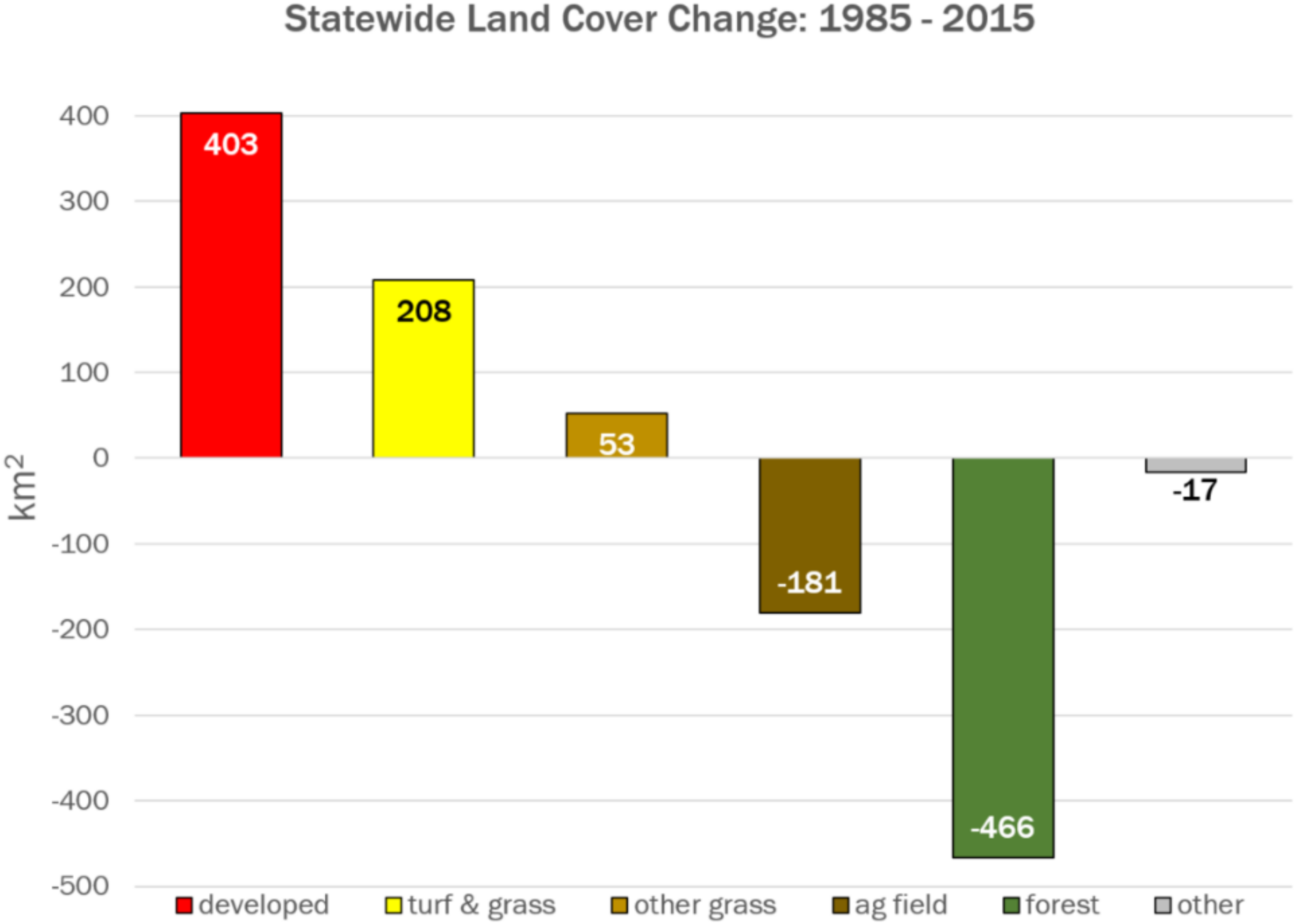
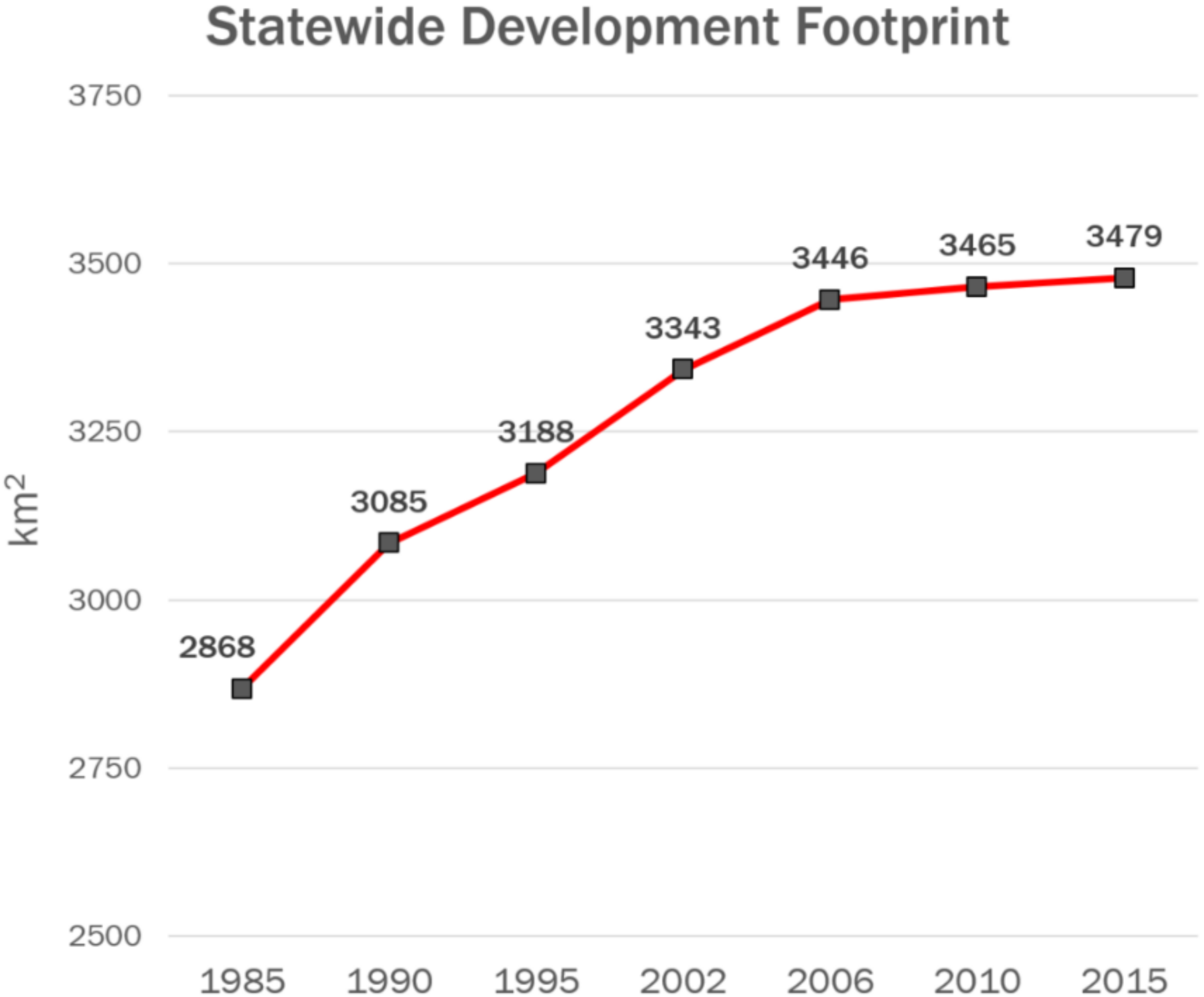
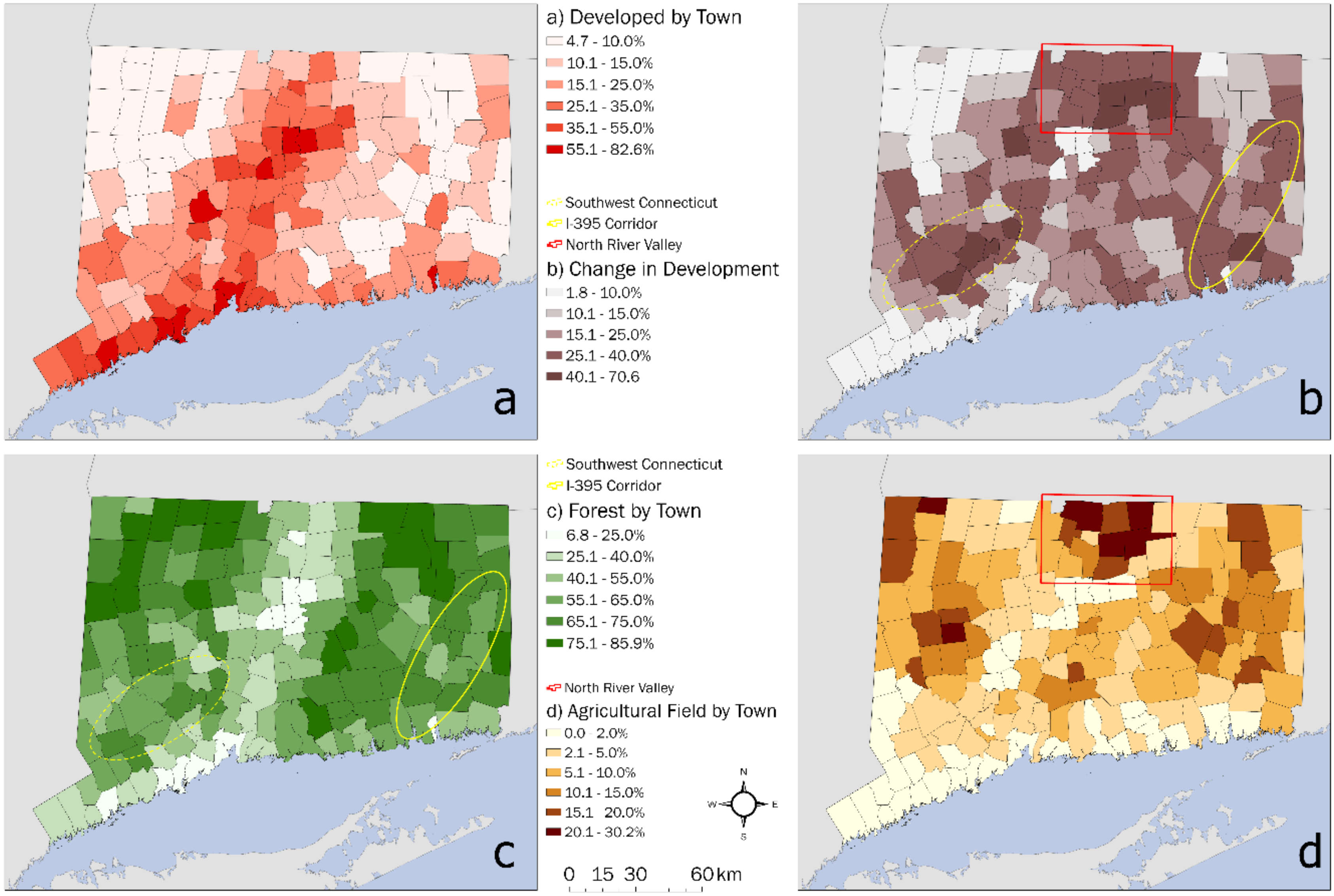
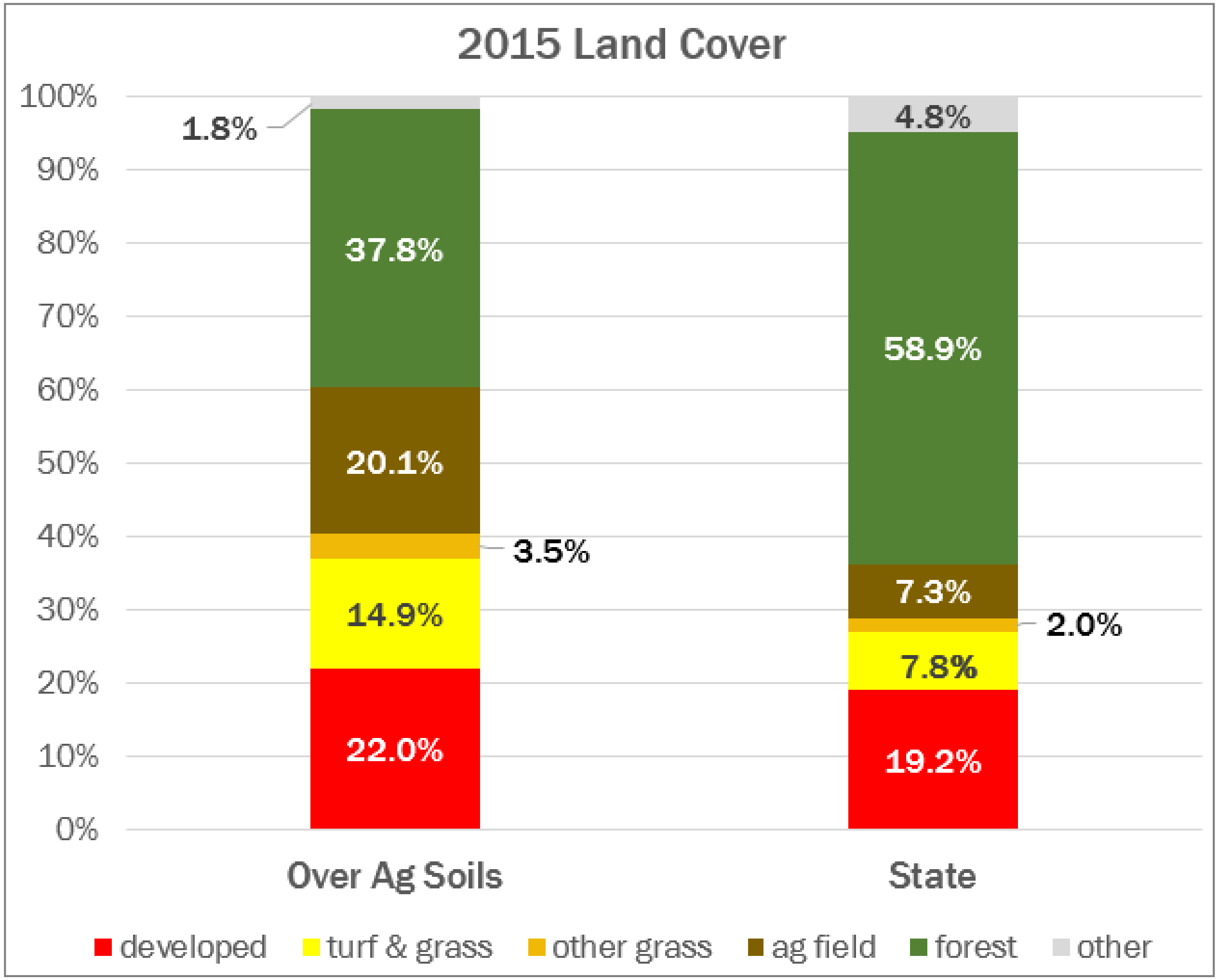

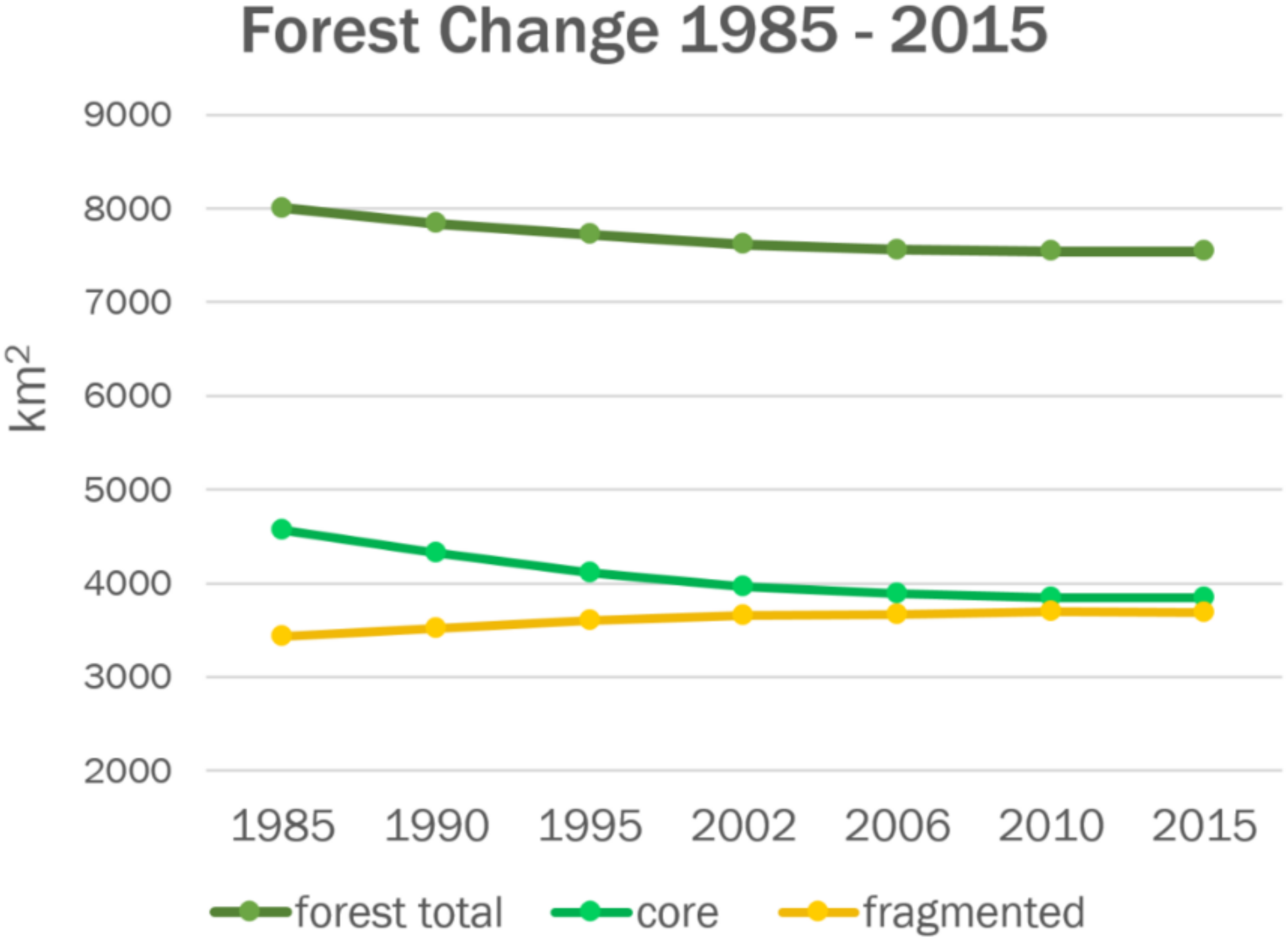
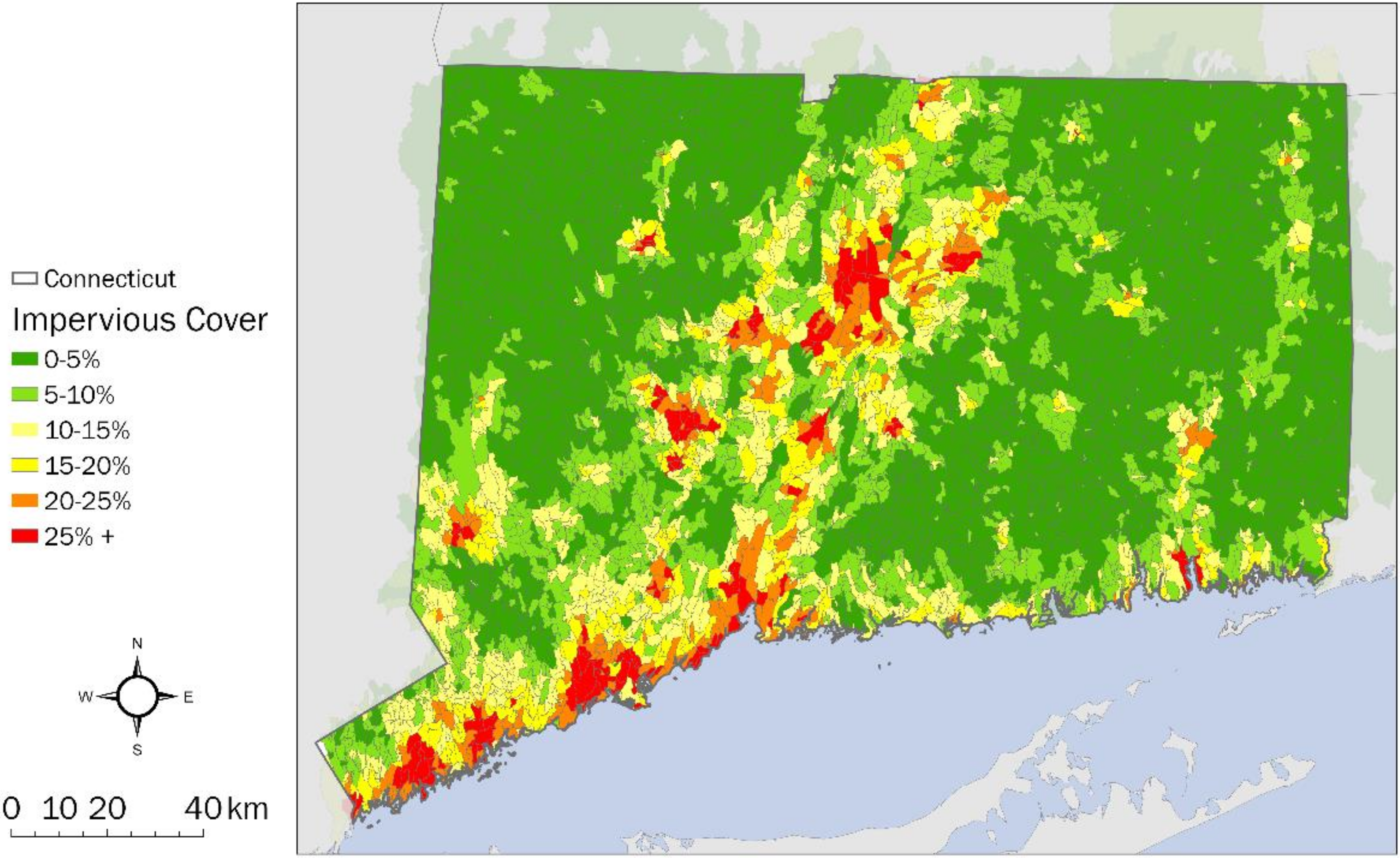

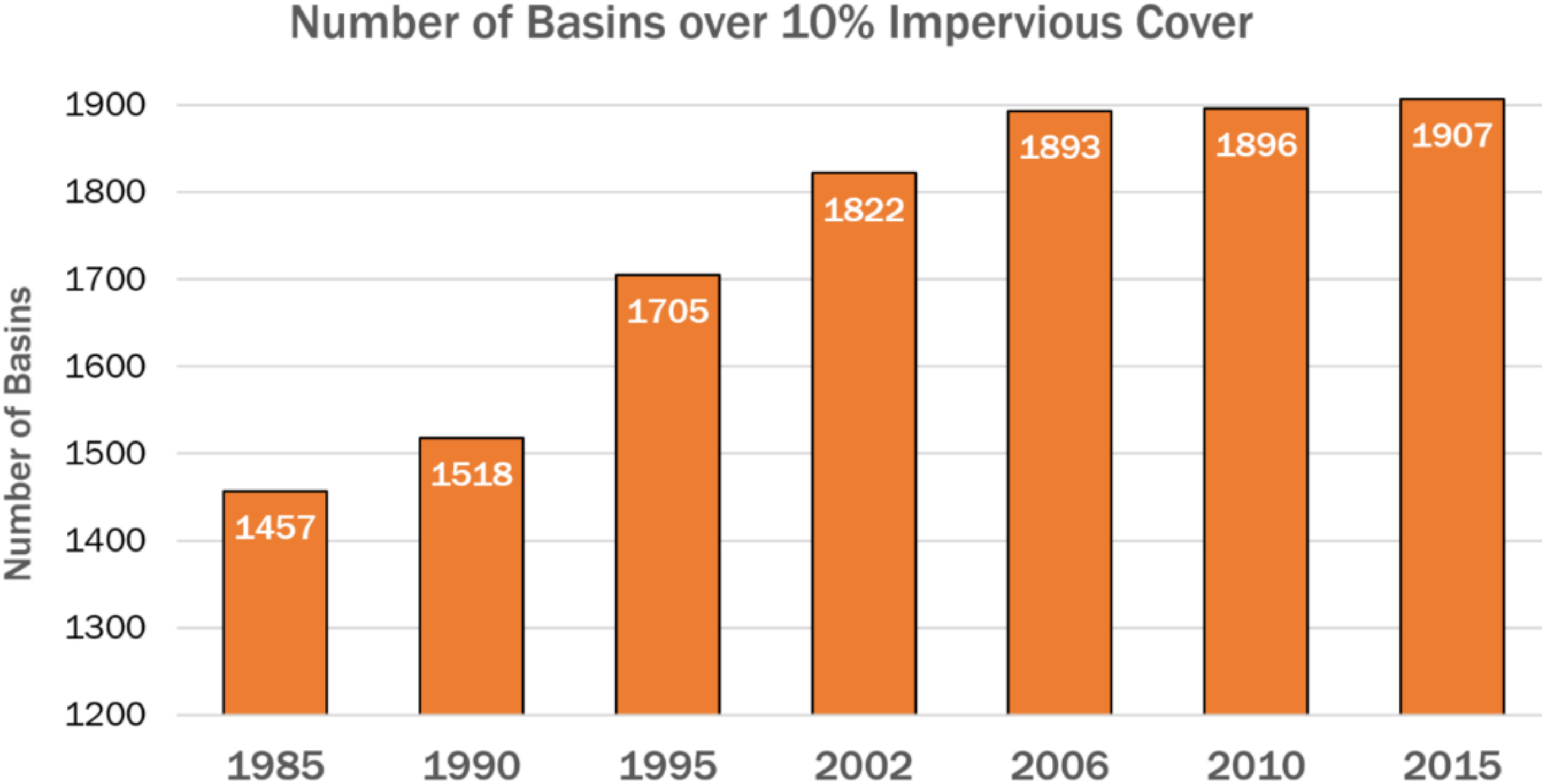

| Class | Description |
|---|---|
| Developed (red) | High-density built-up areas typically associated with commercial, industrial, and residential activities and transportation routes. These areas can be expected to contain a significant amount of impervious surfaces: roofs, roads, and other concrete and asphalt surfaces. |
| Turf and Grass (yellow) | A compound category of undifferentiated maintained grasses associated mostly with developed areas. This class contains cultivated lawns typical of residential neighborhoods, parks, cemeteries, golf courses, turf farms (areas where sod is grown for commercial sale), and other maintained grassy areas. Also, includes some agricultural fields due to similar spectral reflectance properties. |
| Agricultural Field (brown) | Includes areas that are under agricultural uses such as crop production and/or active pasture. Also, likely to include some abandoned agricultural areas that have not undergone conversion to woody vegetation. |
| Forest (green) | A combination of multiple land cover classes including deciduous forest, coniferous forest, forested wetland and utility right-of-way (this class is only identified in forested areas). |
| Area 1985 (Percent) | Area 2015 (Percent) | Change in Percent 1985–2015 | Relative Rate of Change | |
|---|---|---|---|---|
| 91 m corridor | 19.6 | 23.3 | 3.7 | 18.9% |
| statewide | 22.2 | 27.0 | 4.8 | 21.6% |
© 2020 by the authors. Licensee MDPI, Basel, Switzerland. This article is an open access article distributed under the terms and conditions of the Creative Commons Attribution (CC BY) license (http://creativecommons.org/licenses/by/4.0/).
Share and Cite
Arnold, C.; Wilson, E.; Hurd, J.; Civco, D. 30 Years of Land Cover Change in Connecticut, USA: A Case Study of Long-Term Research, Dissemination of Results, and Their Use in Land Use Planning and Natural Resource Conservation. Land 2020, 9, 255. https://doi.org/10.3390/land9080255
Arnold C, Wilson E, Hurd J, Civco D. 30 Years of Land Cover Change in Connecticut, USA: A Case Study of Long-Term Research, Dissemination of Results, and Their Use in Land Use Planning and Natural Resource Conservation. Land. 2020; 9(8):255. https://doi.org/10.3390/land9080255
Chicago/Turabian StyleArnold, Chester, Emily Wilson, James Hurd, and Daniel Civco. 2020. "30 Years of Land Cover Change in Connecticut, USA: A Case Study of Long-Term Research, Dissemination of Results, and Their Use in Land Use Planning and Natural Resource Conservation" Land 9, no. 8: 255. https://doi.org/10.3390/land9080255





